Heliopolis (Baalbek)
Q178835Baalbek or Heliopolis (Greek: Ἡλιούπολις, "sun city"): town in the northern Bekaa valley, site of the largest sanctuary in the Roman world.
Origins
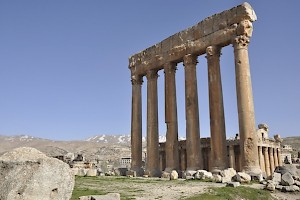
As a site of human occupation, Baalbek is extremely old. Archaeological soundings in the Great Court of the temple of Jupiter revealed ceramics from a settlement from the Chalcolithic and Early Bronze Age (i.e., the fourth and third millenniums BCE), as well as architectural remains from the Middle Bronze Age (about 1950-1600). This first settlement had been on the hilltop, and it is likely that this place remained the focus of some kind of worship, because even after many centuries, the builders of the temple of Jupiter took great care to build the small altar on the Great Court exactly on the summit, while a large terrace was built to make sure that the sanctuary was at the same level as the ancient hilltop.
The name Baalbek may offer a clue about the nature of the original cult: the word probably is a shortening of Semitic Ba'al Nebeq, "lord of the source". We should be careful, though: the name is not attested prior to the fifth century CE. Nevertheless, there is, indeed, a well some 800 meters southeast of the sanctuary, nowadays called Ras al-Ain ("head of the source"). The Greek topographer Strabonote refers to an Aramaean myth about a dragon named Typhon who had been struck by a bolt of lightning and fled underground, cutting the earth, forming a river bed, and finally causing a fountain to break forth to the surface.
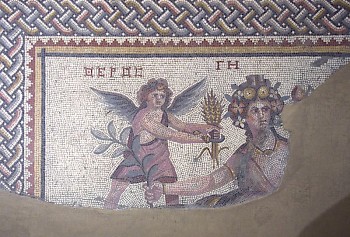
Strabo quotes this story in his account of the Orontes, which has its source fifteen kilometers north of Baalbek. The river passes along ancient towns like Kadesh, Emesa (mod. Homs), Hama, Apamea, Qarqar, and Antioch, until it reaches the sea near Seleucia. To the west of Baalbek are the sources of the Litani (ancient Leontes), which flows south through the Bekaa valley, along Chalkis (mod. Anjar), and empties itself into the Mediterranean near Tyre. The Orontes-Litani valley has always been an important trade route, and Baalbek must have been a nice place to stay, with abundant sources and lots of cereals and fruits for sale.
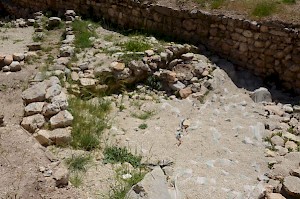
Hardly anything is known about the cult in the Late Bronze Age (if there was a cult!), although we know that in this age, Ba'al became identified with the Syrian Hadad, a fertility god who was also responsible for rain, thunder, and lightning, and had his main sanctuary in Halab (Aleppo). The syncretism of the two deities is attested in the tablets from Ugarit. In Aramaic texts from the Iron Age, this god is the supreme ruler of the other divine beings. So Hadad is attested as head of several local triads.
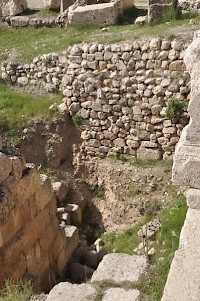
It must be pointed out, however, that although these religious developments took place, and although they do help to explain the nature of the cults in Baalbek at a later date, there is almost no evidence from the site in the Late Bronze and Iron Age. We only know that the place was occupied.
The Hellenistic Age
Baalbek is conspicuously absent from Bronze Age texts, although Egypt was interested in Canaan and the army of Ramesses II passed along the place during the Kadesh campaign (1274). The town is not mentioned in the texts from ancient Assyria; the Bible does not refer to it. Assyrians, Babylonians, Persians, Macedonians: they all passed through the Bekaa valley, but none of them recorded a sanctuary at the sources of the Orontes and Litani. However, the site is possibly identical to the town called Triparadisus, where in 320 BCE the generals of Alexander the Great divided his empire (more).
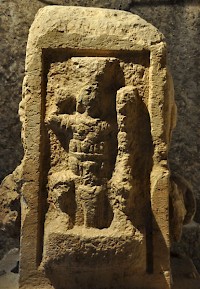
It is certain that the site became part of the empire that Ptolemy I Soter created after the death of Alexander. Maybe, it was in these days that the town was renamed Heliopolis, "sun city". From a local perspective, this name comes unexpectedly, because Ba'al-Hadad was not a sun god. However, in Egypt, the supreme god Ra was also a sun god, and he was worshiped in a town that the Greeks called Heliopolis. The idea to combine Ba'al-Hadad with the sun god, and rename the town, becomes explicable if we assume Egyptian influence.
It may be relevant that the cult statue of the god of Baalbek contained Egyptian elements and was believed to be taken from Egyptian Heliopolis.note On the other hand, there may have been an unrecorded local tradition that the Ba'al of the sources was also a solar deity.
After the Fifth Syrian War (202-195), the Bekaa valley became part of the Seleucid Empire. When this state disintegrated at the beginning of the first century BCE, Heliopolis - if it was already called like this - became part of the small princedom of Chalkis, which in turn became part of the Roman sphere of influence when general Pompey the Great annexed Syria (64). By now, the construction of the sanctuary of Ba'al-Hadad-Zeus-Jupiter had started. Later, in 38 BCE, Mark Antony awarded Chalkis and the sanctuary to the Egyptian queen Cleopatra, making it a Ptolemaic possession again. Not for long, however. Civil war broke out in the Roman Empire, general Octavian was victorious, and annexed Cleopatra's possessions.
Roman Town

The name Colonia Julia Augusta Felix Heliopolitana has caused some debate. The second and third words may be evidence that the site was a settlement of Roman legionary veterans (a colonia) in the age of the emperor Augustus. However, the Roman jurist Ulpian states that Heliopolis became a colonia during the reign of Septimius Severus, after the civil war against Pecennius Niger in 193/194.note He is probably right, and references to coloniae prior to this date must refer to Berytus.
However this may be, from all over the Roman world, pilgrims came to the sanctuary of the god that was now called Jupiter Optimus Maximus Heliopolitanus, "the best and greatest Jupiter of Heliopolis", a title that meant that the Romans identified the deity with their own supreme god, venerated on the Capitol. The god, who was already a supreme god, lord of the sources, responsible for rain and lightning, had in the meantime also accepted responsibility as an oracular god.
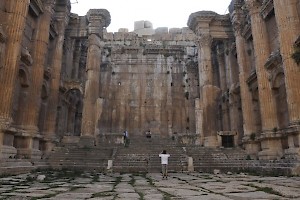
The sanctuary itself was more or less completed during the reign of the emperor Nero (r.54-68). The construction of the temple of Bacchus started at more or less the same moment. Building lasted until the reign of Antoninus Pius (r.138-161), who also completed the Great Court of the temple of Jupiter. The celebrations must have been quite impressive: writing several centuries later, the Antiochene chronicler John Malalas believed Antoninus to have been the builder of all of Heliopolis.
The emperor Septimius Severus and his son Caracalla (r.211-217) built the temple of Venus and added the Propylaea to the sanctuary of Jupiter. The Hexagonal Court appears to have been renovated by Philip the Arab (r.244-249), but remained unfinished. The latter may also have built the temple of Mercury, which is known from coins but has not survived.
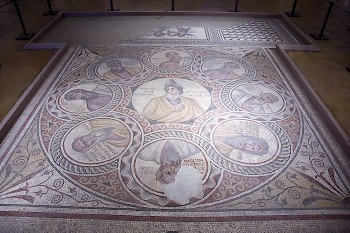
The temple, the largest in the Roman world, served as an oracle. The Latin author Macrobius has recorded that Jupiter of Heliopolis announced that the emperor Trajan would not return from his expedition against the Parthian Empire. Macrobius also tells that during a session of the oracle, the statue was placed in a litter; the bearers sort of sensed the divine will and carried it in certain directions, which could be "decoded" by the priests.note
Late Antiquity
The city flourished; the splendid third-century mosaics from the Suweydie villa are among the evidence. The rise of Christianity in the fourth century, however, marked the decline of the cult of Jupiter Heliopolitanus. Of course, in a center of paganism, the ancient cult died slowly.
There was probably an active persecution of Christians in Heliopolis. Writing in the second quarter of the fifth century, bishop Theodoret tells how, during the reign of the emperor Julian (r. 361-363), a deacon named Cyrillus was killed; his murderers reportedly cut open his belly to devour his liver.note Another legend, recorded by Sozomen, refers to pious virgins devoured by swine.note A letter by bishop Peter II of Alexandria (r.373-380), excerpted by Theodoret, refers to Heliopolis as "a place where none of the inhabitants, who are all given over to idols, can endure so much as to hear the name of Christ".note
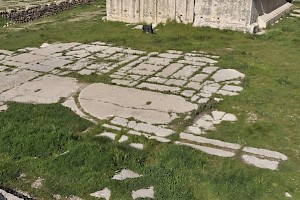
In spite of the persecutions, Christianity was eventually victorious. A church was built in the sanctuary. It consisted of a basilica (on the Great Court) and a dome (on the Hexagonal Court). Many Christians could not believe that the pagans had built the sublime complex, and argued that it had in fact been built by king Solomon. One of them was Pseudo-Zacharias of Mytilene, who also recorded that in 524/525, the building was destroyed by lightning.note Because he believed it was a building by Solomo, the irony was lost on him: lightning destroying the shrine of a lightning god.
Still, the cult for the lightning god continued, although in a different shape. According to Christian legend, a pagan dignitary from Baalbek named Dioscurus had killed his daughter Barbara after he had learned of her baptism, and he was immediately struck by lightning. Therefore, Saint Barbara is invoked if people want to be protected against lightning.
At the end of the sixth century, John of Ephesus (c.507 - c.586) tells an unpleasant story about the last pagans of Baalbek.note When the emperor Tiberius II (r.578-582) learned that the inhabitants of the ancient city had made plans to kill their Christian fellow-citizens, he ordered a general named Theophilus to take measures. He had the pagans crucified.
Middle Ages
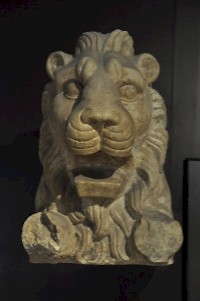
Conquered in 634 by the Arab general Abu 'Ubaidah ibn al-Jarrah, Baalbek received its original name again; on seventh-century coins, it is called Ba'labakk. The Umayyad mosque in the town, built on the former forum, is one of the oldest places of worship of the Islamic world.
The church in the ancient sanctuary was later abandoned and the shrine was dismantled. The stones were used, in the age of the Crusades, to convert the complex into a fortress. Today, it is still called Qalaa, "fort".
Excavation started after the visit of the German emperor Wilhelm II in 1898, who sent Robert Koldewey to investigate the site. His name has been cut into one of the walls of the temple of Bacchus. Like the emperors before him, he added something to the monument: the stairs to the Propylaea.